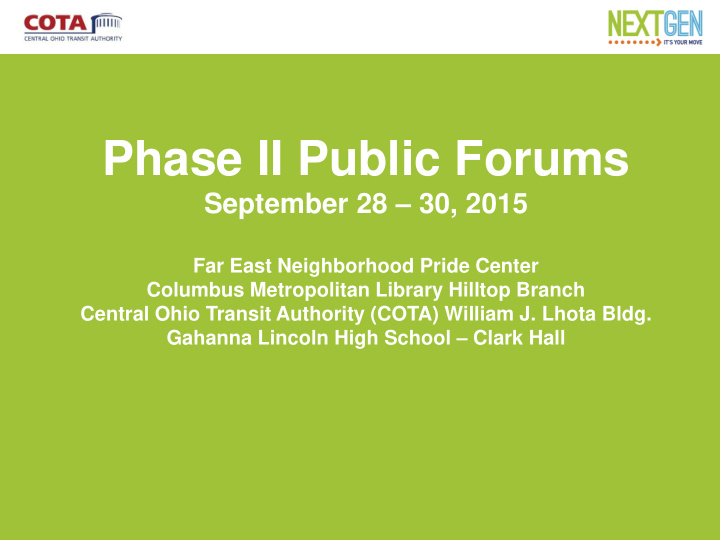



Phase II Public Forums September 28 – 30, 2015 Far East Neighborhood Pride Center Columbus Metropolitan Library Hilltop Branch Central Ohio Transit Authority (COTA) William J. Lhota Bldg. Gahanna Lincoln High School – Clark Hall
Agenda ● Introductions ● Where Do You Want to Go? ● Project Overview ● Phase I Public Outreach & Results ● Transit Needs Assessment ● NextGen Vision: 2050 Potential Service Improvements and High Capacity Transit Corridors ● Discussion & Next Steps 2
Where Do You Want to Go? View NextGen Video
Project Overview
Goals and Overview ● Create a community vision for the future of public transportation in central Ohio – consider all ideas, not restricted by funding ● Prepare for future growth - 28% more people, 22% more jobs - by identifying transit investments that integrate with regional goals ● Support local and regional plans with transit investment options (e.g. Connect ColumbUS and MORPC Metropolitan Transportation Plan) ● Identify conventional and creative revenue options – outcome will be the community’s plan with a list of projects and creative funding options (Spring, 2016) 5
Study Overview We are here 6
Phase I Outreach & Results 7 7
Phase 1 Outreach: March – July ● 2 NextGen Project Advisory Group meetings ● 18 community leader interviews ● 4 targeted stakeholder meetings ● 6 public meetings, online public meeting materials available 24/7 ● 3 stakeholder workshops ● 3 neighborhood sessions ● 5 community organization presentations ● Presence at Connect Columbus meetings; online comments Total = 42 events / 530+ attendees 8
Needs Identified in Public Process Connections Votes Places Votes Places, Continued Votes Downtown to CMH 46 Downtown 27 Gahanna 6 High Street Corridor 30 Port Columbus 25 Worthington 6 Dublin 20 Broad Street Corridor 14 Polaris 5 Grove City 14 Obetz 5 CMH / Gahanna / Easton 13 Grandview 11 Pickerington 5 Downtown to Dublin 12 Hilliard 11 Downtown to Grove City 9 South Columbus 5 Groveport 11 Bexley 4 Powell / Dublin / Hilliard 8 North Columbus/Southern Whitehall 4 Downtown to Worthington 6 10 Delaware County Canal Winchester 3 Bethel Rd / Morse Rd 5 Westerville 10 Upper Arlington 3 Reynoldsburg / Pickerington / 5 Rickenbacker Airport 9 Brice OSU 9 Downtown to Polaris 4 Delaware County 7 Downtown to Easton 4 New Albany 7 Downtown to Rickenbacker 3 Easton 6 Downtown to Westerville 3 9
Transit Needs Assessment
Transit Needs Assessment ● Public and stakeholder input ● Local and regional plans, including COTA’s TSR Plan ● Existing and projected population and employment patterns ● Existing and projected congestion levels ● Existing and projected regional and local travel patterns ● Demographic information ● Site and streetscape design 11
Projected Population and Jobs 2015 2050 28% more people 22% more jobs Source: Mid-Ohio Regional Planning Commission 12
Projected Congestion 2015 2050 Source: Mid-Ohio Regional Planning Commission 13
Phase II: NextGen Vision 14 14
NextGen Vision: Potential Service Enhancements
NextGen Vision Potential Service Improvements ● Enhance COTA system and other local transit to accommodate future population and job growth ● Build strong network of underlying service ● Use innovative service and capital improvements to target specific markets 16
Existing Service 17
2017 TSR Network 18
Vision: Service Improvements ● This map is not exhaustive! 19
Vision: Service Improvements ● Improve Frequent Transit Network ● More frequency on more routes, and longer spans of service 20
Vision: Service Improvements ● More local routes and urban circulators 21
Vision: Service Improvements ● More commuter routes ● Reverse commute service 22
Vision: Service Improvements ● Suburban bus circulators and flex routes 23
Vision: Service Improvements Transit for Seniors and People with Disabilities Demand response service for seniors and people with disabilities ● Expand service for the elderly and people with disabilities with region-wide demand response service ● Curb-to-curb service provided using small transit vehicles 24
Vision: Service Improvements Supporting Capital Elements ● Technology – Transit Signal Priority – On-vehicle information – Real-time information – Cashless fare technology ● Transit Centers ● Bus on Shoulder ● Dedicated Lane or Right of Way ● Stop Amenities 25
NextGen Vision: Potential High Capacity Transit Corridors
High Capacity Transit Corridor Definition ● Moves more people than a typical bus, and typically has fewer stops, higher speeds, and more frequent service than local bus service ● Can be either rubber tired (bus) or steel wheeled (rail) ● Designed to be as congestion-proof as possible ● Includes major corridor infrastructure improvements ● Complements underlying service 27
Examples: High Capacity Transit Modes* * NextGen Vision is not mode specific. Modes identified later in process. 28
Corridor Enhancements 29
NextGen Vision Potential High Capacity Transit Corridors ● Twenty-six corridors identified based on existing or projected strong market demand and public input ● Modes to be identified later in process – Federal requirement to consider all modes when moving into project development 30
31
Where Do You Want to Go? Discussion After you have a chance to study the vision maps: ● On the system improvements map, prioritize your top four investment priorities (type of service) – or suggest another priority ● On the high capacity map, circle your top five recommended corridors ● Fill out the comment form 32
Online Survey – Spread the Word!
Interactive Online Survey http://www.cota.com/nextgen Sept. 28 - Oct. 30 ● Introduction ● Prioritization exercises ● Comment area Help spread the word! 34
Project Next Steps
Next Steps ● Extensive community outreach – we’ll come to your meeting! ● Make adjustments to Vision based on public input ● Evaluate high capacity corridors ● Share results with the public and seek input in winter/spring 2016 36
Thank you! NextGen@COTA.com
Recommend
More recommend